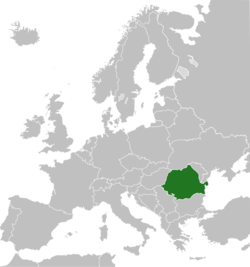Wikijunior Europe: Romania

Romania is a large country in south-eastern Europe. It shares borders with Ukraine, Moldova, Bulgaria, Serbia and Hungary. The capital city is Bucharest. Other big cities are Cluj-Napoca, Timișoara and Iași. Romania joined the European Union on 1st January, 2007 and uses the Romanian Leu as its currency..
Romania's History
editBetween 1945 and 1989 Romania was a Communist country and part of the Warsaw Pact group of central and eastern European countries. In 1947 the country became a Republic and the last king of Romania left the country. Between 1965 and 1989 Nicolae Ceaușescu ruled over the country as President. Enemies of the government were sent to prison or killed. On 25th December 1989 Nicolae Ceaușescu was removed from power and tried to escape from the country but he was captured and executed later.
Since 1989 Romania has been a democratic country with a growing economy. The financial crisis of the late 2000s and early 2010s has created problems.
Romania's Geography
editWith a surface area of 238,391 square kilometres (92,043 sq mi), Romania is the largest country in south-eastern Europe. Romania has the 9th largest territory and the 7th largest population in the EU. Romania's natural landscape is almost evenly divided among mountains, hills, and plains. Spring is pleasant with cool mornings and nights and warm days. Summers are generally very warm to hot. Autumn is dry and cool, with fields and trees producing colorful foliage. Winters tend to be very cold and foggy.
The River Danube (Europe's longest river) forms part of the borders between Romania and Serbia and Bulgaria and on Romania's Black Sea coast the river flows into the sea. 5% of Romania's territory is protected as part of the National Park system. At 2544 metres, Moldoveanu Peak is Romania's highest mountain.
Romania's People
editRomania has a population of 20.1 million. Romanians make up 90 percent of the population. The largest ethnic minorities are Hungarians, who make up 7 percent of the population and Roma (Gypsy) who make up 3 percent of the population. The official language of Romania is Romanian. Romanian is spoken as a first language by 91% of the population, with Hungarian and Roma, being the most important minority languages. The dominant religious body is the Romanian Orthodox Church. Over 1,000,000 Romanians currently live abroad mainly in Germany, Spain and Italy.
Romania Sights
editTourism focuses on the country's natural landscapes and its rich history. Some fun things to do in Romania include camping and hiking in the Carpathian Mountains, skiing at Poiana Braşov and on Valea Prahovei, the Black Sea Romanian resorts, the medieval churches and monasteries of Moldavia and Bukovina, the Danube Delta, the best preserved delta of Europe, Sighişoara town and medieval festival, the medieval Castles of Transylvania, the folklore and traditions of Maramureş, rural tourism, spas and health resorts, visiting the cultural cities of Brasov, Iaşi, Timişoara, Cluj-Napoca, Bucharest and Alba Iulia, and museums.
There are 7 UNESCO World Heritage Sites in Romania. These sites include Sighişoara in Transylvania and Danube Delta (the area where the mighty Danube river meets the Black Sea).
| Wikijunior Europe • Intro • EU • Geo • People • Language • Facts • Quiz | edit | ||